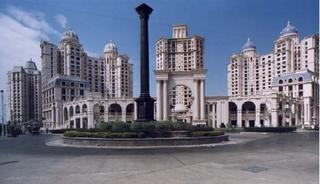Foreign Direct Investment in Real Estate in India

Article by: Pushpendra Sharma
Indian Real Estate Market Size
The Real Estate Industry in India is currently estimated to be in the region of US 12 billion dollars. It is expected to grow at the rate of approximately 30 per cent annually. The housing sector in India is expected to grow at a pace of 50% in the next four years (2005-2009). According to Smith Barney, Construction is 12% of India’s GDP and accounts for 40-50% of domestic fixed capital formation. The Investments in the Housing sector has steadily increased from Rs. 1150 cr in the First Plan period to more than Rs. 1,20,000 cr in the Ninth Plan period. Estimates of the Tenth Plan peg the figure at about Rs. 7,00,000 cr.
FDI backed projects would be accorded national treatment at par with local developers - State Government /Municipal bodies would now approve projects for construction – development involving foreign investment.
Overview of the TOP 8 sectors in India in relation to FDI (Foreign Direct Investment)
1. Integrated Townships
It is estimated that the urban housing sector in India will require investments worth $ 20-$24 billion over the next five-year period. The Govt. is keen that much of the need of housing be met through the concept of integrated townships. The recent change has seen a significant interest and spurt of activity in the housing market by domestic and international players.
Previous FDI Policy
100% foreign investment allowed only in townships of a size of minimum of 100 acres planned with a minimum of 2,000 dwelling units.
New Policy 2005
100% foreign investment continues to be allowed in a minimum land size of 25 acres.
2. Residential / Housing
Plotted housing projects are defined as projects wherein investor acquires raw land and provides for infrastructure (power/utilities) and further sells down individual plots within such a development to individual home owners who may develop their own houses.
Previous FDI Policy
100% foreign investment in residential asset class was allowed only in townships of a size of minimum of 100 acres planned with a minimum of 2,000 dwelling units.
New Policy 2005
100% foreign investment is allowed in any kind of residential development subject to a minimum proposed built up area of 50,000 square metres. Such an investment needs to be Greenfield in nature and not acquisition of a developed property.
Remarks
100% foreign investment apart from being allowed in development of residential properties is also allowed in development of plotted housing projects. In order to be eligible for foreign investments, the minimum size of land for such developments should not be less than 25 acres. India has an acute shortage of dwelling units. Usable Housing Stock has risen from 70 million units in 1961 to 170 million units in 2001, which was an official shortfall of 19 million units.
3. Commercial Buildings (Office Space)
Previous FDI Policy
Foreign investment not allowed in pure office developments – as being different from IT and business parks.
New Policy 2005
Foreign investment is allowed in city centre or suburban office buildings even if the occupiers were not classified as forming part of the IT/ Back office sector.
Remarks
However, under the new regime, such an investment is allowed only at the construction stage and for projects of proposed built up area of a minimum of 50,000 square metres.
4. IT/ITES Sector
Previous FDI Policy
100% foreign investment allowed in IT / Business parks approved under Industrial Parks Scheme 2002 (whereas in reality, suburban office buildings have been occupied only by IT companies or by companies engaged in back office processing activity)
New Policy 2005
No change
Remarks
In the previous regime, foreign investment was allowed in IT Parks at the construction stage, subject to that such parks proposed to provide space to at least 3 tenants. Under the new regime, even facilities that are proposed to be occupied by a single tenant only are eligible for foreign investment at the construction stage but subject to a proposed minimum built up area of 50,000 square metres. Thus, foreign investors can now invest even in part of a business park or a standalone office facility dedicated to a single tenant at the construction stage, provided the proposed minimum built up area of 50,000 square metres.
BPO Industry has fueled growth of the real estate sector in India. Technology sector has absorbed more than 60 million sq. ft. of new commercial office space in India over the past 5 years, which is more than 70% of the total demand. Government if simplifying policies & procedures for setting up operations offering incentives, including stamp duty rebates on leases & lower property taxes. 6 top cities for BPO investments – New Delhi, Mumbai, Pune, Bangalore, Hyderabad & Chennai.
5. Retail & Entertainment Areas (Shopping Centres/ Malls)
Previous FDI Policy
Foreign investment was not allowed in shopping centres/malls.
New Policy 2005
100% foreign investment is allowed in development of such facilities by international investors.
Remarks
However, such an investment by foreign investors would be allowed only at the construction stage, subject to a proposed minimum built up area of 50,000 square metres. It may be noted that there has been no change in the government’s policy to not allow international retailing companies to establish operations in India. Retail and entertainment areas include Malls, Multiplexes, Family Entertainment Centres, Franchises and Restaurant chains.
6. Special Economic Zones
Previous FDI Policy
100% foreign investment was allowed in real estate development within SEZ projects.
New Policy 2005
100% foreign investment was allowed in real estate development within SEZ projects.
Remarks
The regime for real estate components of the SEZ schemes was always open to foreign investments. The February 2005 announcement has no impact on the said asset class.
7. Infrastructure (Roads/Warehouses/Logistics/Ports)
Previous FDI Policy
Framework of foreign investment by international investors (and not just international occupiers
themselves) was unclear in nature.
New Policy 2005
100% foreign investment is allowed in development of such facilities even by international investors.
Remarks
However, such an investment by foreign investors would be allowed only at the construction stage, subject to a proposed minimum built up area of 50,000 square metres.
8. Hospitality & Recreation / Serviced Apartments
In June 2003, there were 226 projects worth Rs. 13,000 crore, of which Rs. 5,000 crore was under construction. There are 60,000 hotel rooms in India, of which 30% are in the premium segment. Most hotel rooms (over 25%) in India are concentrated in Mumbai and New Delhi. This industry is buoyant with significant new projects, rising occupancy rates and hotel room rates. Although Mumbai has the most hotels, Bangalore is noted as having some of the best hotels in Asia. Shangri-La, one of the world’s premier chains has entered India. Major US hotels/REITs are also exploring the market.
Previous FDI Policy
100% foreign investment allowed in development or acquisition of existing assets
New Policy 2005
No Change
Remarks
The regime for hotels, resorts and serviced apartments was always opened to foreign investments. Hence February 2005 announcement has no impact on the said asset class.
Lastly after looking at all the investment opportunities that the current government has announced in the recent budget inorder to attract foreign investment, I can say that in the coming years, India will witness tremendous economic growth across all sectors, particularly in the field of real estate and infrastructure.


